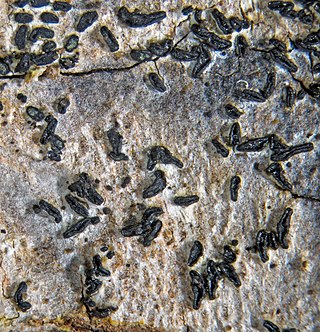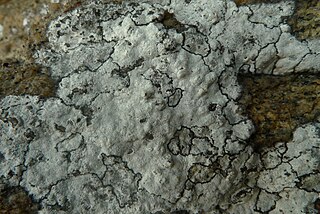
The Arthoniales is the second largest order of mainly crustose lichens, but fruticose lichens are present as well. The order contains around 1500 species, while the largest order with lichenized fungi, the Lecanorales, contains more than 14000 species.

The Arthoniaceae are a family of lichenized, lichenicolous and saprobic fungi in the order Arthoniales. The Arthoniaceae is the largest family of Arthoniales, with around 800 species. Most species in Arthoniaceae belong in Arthonia which is the largest genus with 500 species. The second and third largest genus is Arthothelium with 80 species, and Cryptothecia with 60 species.

Melaspileaceae is a family of lichenized, lichenicolous and saprobic fungi within Ascomycota. These fungi have long been poorly understood, and the family's taxonomic position has been unclear because of insufficient molecular data. It was previously included in the order Arthoniales but recent phylogenetic analyses indicate that it instead belongs to the order Eremithallales.

The Roccellaceae are a family of fungi in the order Arthoniales, circumscribed by French botanist François Fulgis Chevallier in 1826. This family is distinguished by a wide variety of growth forms, including crustose and fruticose thalli, and a diverse range of reproductive structures. Roccellaceae species typically have apotheciate or lirellate ascomata, often with distinct carbonised (blackened) margins. The family has been extensively studied through molecular phylogenetics, revealing significant genetic diversity and complex evolutionary histories.

Alyxoria is a genus of lichen-forming fungi in the family Lecanographaceae.

Lecanographaceae is a family of mostly lichens in the order Arthoniales. The family was circumscribed in 2014, prompted by a molecular phylogenetic-based restructuring of the Arthoniales.

Emmanuël Sérusiaux is a Belgian lichenologist. His career, spanning more than four decades, has combined both lichenology research and political aspects of nature conservation. He spent several periods working as a researcher at the National Fund for Scientific Research and the University of Liège, the latter in which he accepted a faculty position as professor and head of the Plant Taxonomy and Conservation Biology unit. Sérusiaux also served for three non-consecutive appointments as Deputy Chief of Staff in the Government of Wallonia. He retired from both his academic and political positions in 2019.

Opegraphaceae is a family of lichen-forming and lichenicolous fungi in the order Arthoniales. It was originally proposed by German lichenologist Ernst Stizenberger in 1862. It fell into disuse, but was resurrected in a molecular phylogenetic study of the order Arthoniales published in 2010. It now includes taxa that were previously referred to the family Roccellaceae, its sister group.

Roccellographaceae is a family of lichen-forming fungi in the order Arthoniales. It contains three genera: Dimidiographa, Fulvophyton, and Roccellographa.
Gyrographa is a genus of lichen-forming fungi in the family Roccellaceae. The genus was circumscribed in 2014 by Damien Ernst and Anders Tehler, with Gyrographa gyrocarpa assigned as the type species. This lichen, originally described by Julius von Flotow in 1825, was first placed in the genus Opegrapha. Species in the genus have a crustose thallus lacking a cortex, and a dark brown prothallus. The photobiont partner is trentepholioid. The hypothecium is thick and carbonised, and the ascospores lack a gelatinous sheath; these characteristics distinguish it from Opegrapha species. The genus name alludes to the gyrose ascomata of the type species.
Diromma is a monotypic fungal genus in the family Roccellaceae. It contains the single species Diromma dirinellum, a rare crustose lichen that grows as a parasite on the lichen Dirina ceratoniae. It has a distribution restricted to the Mediterranean Basin.

Pseudoschismatomma is a monotypic fungal genus in the family Roccellaceae. It contains the single species Pseudoschismatomma rufescens, a corticolous (bark-dwelling), crustose lichen. This species was first described in 1794 by Christiaan Hendrik Persoon as Opegrapha rufescens. Pseudoschismatomma was circumscribed in 2014 by Damien Ernst and Anders Tehler, following molecular phylogenetic analysis and revision of the Roccellaceae. The genus name alludes to its similarity with genus Schismatomma, particularly S. graphidioides. It differs from this species in having a distinct brown true exciple.
Ocellomma is a genus of lichen-forming fungi in the family Roccellaceae. The genus was circumscribed in 2014 by Damien Ertz and Anders Tehler, following a molecular phylogenetic-based revision of the Roccellaceae. The type species, O. picconianum, was originally named Lecania picconiana by Francesco Baglietto in 1862, described from specimens collected in Italy. DNA-based phylogenetic analysis showed that it occupied a distinct genetic lineage, deserving of recognition as a new genus. The genus name Ocellomma alludes to the whitish rims on the small ascomata that contrast with the discs, giving them the appearance of small eyes.
Vigneronia spieri is a species of corticolous (bark-dwelling), crustose lichen in the family Roccellaceae. It is found in the Galápagos Islands, mainland Ecuador and the Antilles (Curaçao).
Plectocarpon galapagoense is a species of lichenicolous fungus in the family Lecanographaceae. Native to the Galápagos Islands, it grows on and within the ascomata and thallus of Sarcographa tricosa, a host lichen species. Although it appears to be a weak parasite, it may cause significant damage to the host lichen's reproductive structures.
Dimidiographa is a genus of lichen-forming fungi in the family Roccellographaceae. It has three species of crustose lichens, with Dimidiographa loandensis serving as the type species.
Fouragea is a genus of lichen-forming fungi in the family Opegraphaceae. It has nine species.

Fulvophyton is a genus of lichen-forming fungi in the family Roccellographaceae. It has 11 species. Fulvophyton is characterised by its crust-like thallus, which is often pale yellowish-brown in colour. This genus features a photobiont from the green algal genus Trentepohlia and exhibits a unique arrangement of reproductive structures.
Lecanactis borbonica is a rare species of corticolous (bark-dwelling), lichen in the family Roccellaceae. Found exclusively in Réunion, it forms a crustose thallus and is characterised by its rounded ascomata and the presence of specific chemical compounds.
Neosergipea hyphosa is a species of corticolous (bark-dwelling) lichen in the family Roccellaceae. This lichen species is uniquely characterised by its olive-green thallus—a type of vegetative tissue—and spherical ascomata, or fungal reproductive structures. It is most commonly found on tree bark in Brazil. The name hyphosa alludes to the distinct hyphose surface of the thallus.











